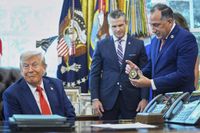At a press conference held on Monday, August 25, 2025, President Donald Trump received an honorary U.S. Marshals badge in a ceremony that quickly drew both attention and amusement across the political spectrum. The event, which took place during the unveiling of a new executive order, featured Attorney General Pam Bondi and Gady Serralta, the director of the United States Marshals Service, presenting the badge and a symbolic handcuff key to the president. The gesture, while warmly received by Trump, has since sparked a flurry of commentary about the meaning and frequency of such honorary awards.
According to reporting from both Rolling Stone and The Onion, the exchange was as much about theater as it was about recognition. Attorney General Bondi, standing beside the president with a broad grin, introduced Serralta by saying, "I think Gady Serralta had something he wanted to give you on behalf of all of the law enforcement who are out there every single night." Her tone, as noted by Rolling Stone, was reminiscent of how one might address a child on Christmas morning, setting the stage for a moment that was equal parts ceremonial and lighthearted.
Gady Serralta, taking the podium, addressed the president directly: "Mr. President, thank you for putting me in charge of this search as the director of the United States Marshals Service." He continued, "On behalf of all the federal law enforcement agencies that we’re working with, and those that have yet to join the team, we thought it was only appropriate to present you with an honorary United States Marshal service badge." The presentation was accompanied by a handcuff key, a symbolic nod to law enforcement’s work and, as Serralta explained, to the president’s policies.
"You continue, through your policies and your efforts with your staff to un-handcuff law enforcement officers all over this nation," Serralta remarked, voicing gratitude from the law enforcement community. "And I can tell you personally that they thank you for that. You can continue un-handcuffing law enforcement." The phrase, "un-handcuffing law enforcement," was repeated, underscoring a central theme of the administration’s approach to policing—namely, the desire to reduce what it sees as bureaucratic or legislative constraints on officers in the field.
President Trump, visibly pleased, accepted the badge and key with a smile and a brief comment to the assembled press: "That’s very nice." Looking directly at the camera, he added, "That’s a very great honor. I’ll save that and put it some place up, which is important." The moment was, as The Onion described, a display of how easily the president is impressed by gifts, even those of largely symbolic value.
But what exactly is the significance of an honorary badge from the U.S. Marshals Service? As both articles point out, such tokens are not uncommon in American law enforcement culture. Honorary service badges are often distributed as gestures of goodwill or recognition, sometimes to adults, sometimes to children. The most notable recent example, as cited by both sources, was DJ Daniel, a young cancer patient who attended the State of the Union earlier in 2025. Daniel was made an honorary Secret Service member for dressing up and pretending to be a police officer in his hometown—a touching moment that captured the public’s imagination and underscored the symbolic nature of these awards.
Indeed, the practice of bestowing honorary badges stretches back decades, often as a way to build bridges between law enforcement and the communities they serve. Whether it’s a child battling illness or a public official, the gesture is typically meant to convey appreciation or solidarity, rather than confer any actual authority or power. As Rolling Stone notes, such badges are handed out "to just about anyone, even children." The implication is clear: while the badge may look official, its meaning is largely ceremonial.
The president’s delight at the gift did not go unnoticed. "It doesn’t take much to flatter Trump," wrote The Onion, referencing previous instances where the president has been visibly pleased by tokens ranging from gold paperweights to a literal Diet Coke bottle. The moment was captured on video and quickly circulated on social media, with some critics highlighting the childlike glee with which Trump accepted the badge. "Trump is presented with an honorary badge by a sycophant who talks to him like a toddler," tweeted journalist Aaron Rupar, capturing the tone of much of the online commentary.
Yet, for Trump’s supporters and many in law enforcement, the gesture was seen as an appropriate recognition of the administration’s efforts to support police. Serralta’s comments about "un-handcuffing law enforcement" resonated with those who have long argued that restrictive regulations and oversight have hampered officers’ ability to do their jobs. In this light, the honorary badge served as a symbol of gratitude from the law enforcement community, acknowledging what they see as a more supportive federal stance.
For others, however, the optics of the event raised questions about the value and purpose of such ceremonies. Critics argue that the ease with which honorary badges are distributed can diminish their meaning, turning what should be a special recognition into a routine or even trivial gesture. The comparison to DJ Daniel’s honorary Secret Service membership, while heartwarming in that context, also highlights the performative aspect of such awards when given to powerful adults.
Political observers noted that the event fit a familiar pattern for the Trump administration, which has often embraced symbolic gestures and moments of spectacle. Whether it’s the dramatic signing of executive orders or the public bestowal of tokens and awards, these moments are designed to communicate values and priorities to both supporters and detractors. In this case, the message was clear: the administration stands with law enforcement, and it is willing to celebrate that support in highly visible ways.
The badge and key themselves, of course, do not confer any real authority. They are, as both Rolling Stone and The Onion point out, purely honorary—items that will likely end up displayed in a White House office or personal collection. Yet, the symbolism carries weight, especially in a political climate where gestures can sometimes matter as much as policy.
As the news cycle moves on, the image of President Trump accepting his shiny new badge—smiling, perhaps a bit too broadly—will linger as a snapshot of a presidency that has often blurred the lines between ceremony and substance, showmanship and governance. Whether one sees the moment as a harmless bit of pageantry or as a telling commentary on the president’s priorities, it is, in the end, a reflection of the times.
For now, the badge joins a growing collection of presidential mementos, each one a small piece of a much larger story about power, perception, and the enduring appeal of a little bit of shine.




